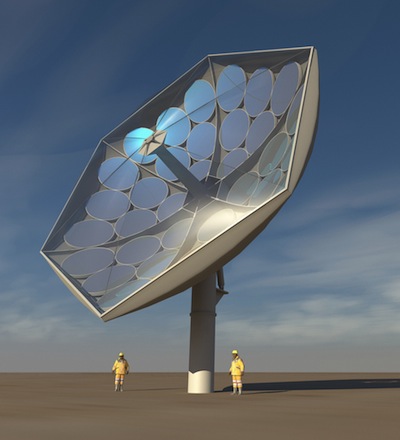Science Fiction
Dictionary
A B C D E F G H I J K L M N O P Q R S T U V W X Y Z
Swiss HCPVT Giant Photovoltaic 'Flower'

A huge flower-shaped photovoltaic system that uses a cooling system inspired by the hierarchical branched blood supply system of the human body.

(From Rendering by Airlight Energy of the prototype HCPVT system under development)
The prototype HCPVT system uses a large parabolic dish, made from many mirror facets, which are attached to a sun-tracking system. The tracking system positions the dish at the best angle to capture the sun’s rays, which then reflect off the mirrors onto several microchannel-liquid-cooled receivers with triple junction photovoltaic chips. Each chip can convert 200–250 watts, on average, over a typical eight hour day in a sunny region.The entire receiver combines hundreds of chips and provides 25 kilowatts of electrical power. The photovoltaic chips are mounted on micro-structured layers that pipe liquid coolants within a few tens of micrometers off the chip to absorb the heat and draw it away 10 times more effectively than with passive air cooling.
The coolant maintains the chips almost at the same temperature for a solar concentration of 2,000 times and can keep them at safe temperatures up to a solar concentration of 5,000 times. The direct cooling solution with very small pumping power is inspired by the hierarchical branched blood supply system of the human body and has been already tested by IBM scientists in high performance computers, including Aquasar. “Microtechnology as known from computer chip manufacturing is crucial to enable such an efficient thermal transfer from the photovoltaic chip over to the cooling liquid,” said Andre Bernard, head of the MNT Institute at NTB Buchs. “And by using innovative ways to fabricate these heat transfer devices we aim at a cost-efficient production.”
I was immediately reminded of the sunshade-photocell collector from David Brin's 1990 novel Earth:
Then he saw the geek - a codger this time - leaning against one of the slender stalks of a sunshade-photocell collector, looking directly at the three of them.
Via Kurzweil AI
Scroll down for more stories in the same category. (Story submitted 5/1/2013)
Follow this kind of news @Technovelgy.| Email | RSS | Blog It | Stumble | del.icio.us | Digg | Reddit |
Would
you like to contribute a story tip?
It's easy:
Get the URL of the story, and the related sf author, and add
it here.
Comment/Join discussion ( 3 )
Related News Stories - (" Engineering ")
Did The Yautja Have These First?
What a marvel of ingenuity the little device was! - Harry Bates, 1934.
Jetson ONE Air Races Begin, Can Air Polo Be Far Behind?
'If you're one of those rarities who haven't attended a rocket-polo "carnage", let me tell you it's a colorful affair.' - John Victor Peterson, 1938.
X-Control Janus-1 A Suitcase Aircraft
'You will notice that it... fits the suitcase nicely.' - E.D. Skinner, 1929.
Time Crystals Can Now Be Seen Directly
'It is as you thought when you constructed the time crystal, my master Vaylan.' - NK Heming, 1952.
Technovelgy (that's tech-novel-gee!) is devoted to the creative science inventions and ideas of sf authors. Look for the Invention Category that interests you, the Glossary, the Invention Timeline, or see what's New.
Science Fiction
Timeline
1600-1899
1900-1939
1940's 1950's
1960's 1970's
1980's 1990's
2000's 2010's
Current News
iPhone Air Fulfils Jobs' Promise From 2007 - A Giant Screen!
'... oblongs were all over the floor and surfaces.'
ChatGPT Now Participates in Group Chats
'...the city was their laboratory in human psychology.'
iPhone Pocket All Sold Out!
'A long, strong, slender net...'
Did The Yautja Have These First?
What a marvel of ingenuity the little device was!
Jetson ONE Air Races Begin, Can Air Polo Be Far Behind?
'If you're one of those rarities who haven't attended a rocket-polo "carnage", let me tell you it's a colorful affair.'
Will Space Stations Have Large Interior Spaces Again?
'They filed clumsily into the battleroom, like children in a swimming pool for the first time, clinging to the handholds along the side.'
Mornine Sales Robot
'Robot-salesmen were everywhere, gesturing...'
Bipedal Robot Floats Gently While Walking
'a walking balloon proceeded with long strides of its aluminum legs...'
Musk Idea Of Cars Talking To Each Other Predicted 70 Years Ago
'My cars talk to one another.'
Elegant Bivouac Shelter Produces Water And Electricity
'There was nowhere on the planet where science and technology could not provide one with a comfortable home...'
X-Control Janus-1 A Suitcase Aircraft
'You will notice that it... fits the suitcase nicely.'
'AI Assistants' Are Actually Less Reliable For News
'Most men updated their PIP on New Year's Day...'
YES!! Remote Teleoperated Robots predicted by Technovelgy!
'...a misshapen, many-tentacled thing about twice the size of a man.'
Will Robots Ever Fold Landry?
Where have you gone, Mrs. Robinson?
Will AIs Give Better Results If You're Rude To Them?
'I said, "Listen up, motherf*cker.'
Cybertruck Robotic Arm F10 Drone Launch!
Drone away!
